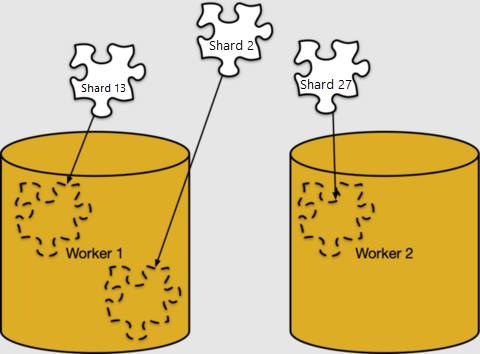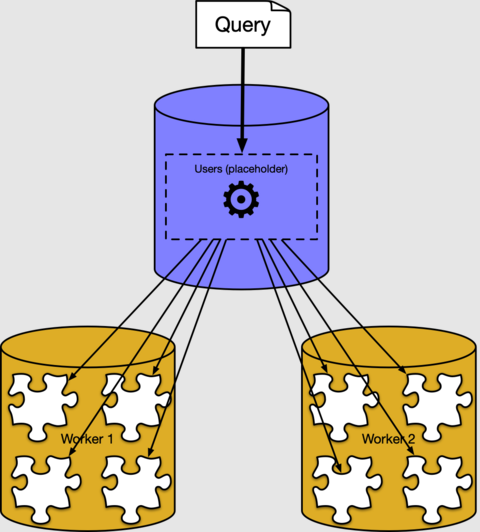Tutorial: Shard data on worker nodes in Azure Cosmos DB for PostgreSQL
APPLIES TO:
Azure Cosmos DB for PostgreSQL (powered by the Citus database
extension to PostgreSQL)
In this tutorial, you use Azure Cosmos DB for PostgreSQL to learn how to:
- Create hash-distributed shards
- See where table shards are placed
- Identify skewed distribution
- Create constraints on distributed tables
- Run queries on distributed data
Prerequisites
This tutorial requires a running cluster with two worker nodes. If you don't have a running cluster, follow the create cluster tutorial and then come back to this one.
Hash-distributed data
Distributing table rows across multiple PostgreSQL servers is a key technique for scalable queries in Azure Cosmos DB for PostgreSQL. Together, multiple nodes can hold more data than a traditional database, and in many cases can use worker CPUs in parallel to execute queries. The concept of hash-distributed tables is also known as row-based sharding.
In the prerequisites section, we created a cluster with two worker nodes.

The coordinator node's metadata tables track workers and distributed data. We can check the active workers in the pg_dist_node table.
select nodeid, nodename from pg_dist_node where isactive;
nodeid | nodename
--------+-----------
1 | 10.0.0.21
2 | 10.0.0.23
Note
Nodenames on Azure Cosmos DB for PostgreSQL are internal IP addresses in a virtual network, and the actual addresses you see may differ.
Rows, shards, and placements
To use the CPU and storage resources of worker nodes, we have to distribute table data throughout the cluster. Distributing a table assigns each row to a logical group called a shard. Let's create a table and distribute it:
-- create a table on the coordinator
create table users ( email text primary key, bday date not null );
-- distribute it into shards on workers
select create_distributed_table('users', 'email');
Azure Cosmos DB for PostgreSQL assigns each row to a shard based on the value of the
distribution column, which, in our case, we specified to be email. Every
row will be in exactly one shard, and every shard can contain multiple rows.

By default create_distributed_table() makes 32 shards, as we can see by
counting in the metadata table
pg_dist_shard:
select logicalrelid, count(shardid)
from pg_dist_shard
group by logicalrelid;
logicalrelid | count
--------------+-------
users | 32
Azure Cosmos DB for PostgreSQL uses the pg_dist_shard table to assign rows to shards,
based on a hash of the value in the distribution column. The hashing details
are unimportant for this tutorial. What matters is that we can query to see
which values map to which shard IDs:
-- Where would a row containing hi@test.com be stored?
-- (The value doesn't have to actually be present in users, the mapping
-- is a mathematical operation consulting pg_dist_shard.)
select get_shard_id_for_distribution_column('users', 'hi@test.com');
get_shard_id_for_distribution_column
--------------------------------------
102008
The mapping of rows to shards is purely logical. Shards must be assigned to specific worker nodes for storage, in what Azure Cosmos DB for PostgreSQL calls shard placement.

We can look at the shard placements in pg_dist_placement. Joining it with the other metadata tables we've seen shows where each shard lives.
-- limit the output to the first five placements
select
shard.logicalrelid as table,
placement.shardid as shard,
node.nodename as host
from
pg_dist_placement placement,
pg_dist_node node,
pg_dist_shard shard
where placement.groupid = node.groupid
and shard.shardid = placement.shardid
order by shard
limit 5;
table | shard | host
-------+--------+------------
users | 102008 | 10.0.0.21
users | 102009 | 10.0.0.23
users | 102010 | 10.0.0.21
users | 102011 | 10.0.0.23
users | 102012 | 10.0.0.21
Data skew
A cluster runs most efficiently when you place data evenly on worker nodes, and when you place related data together on the same workers. In this section we'll focus on the first part, the uniformity of placement.
To demonstrate, let's create sample data for our users table:
-- load sample data
insert into users
select
md5(random()::text) || '@test.com',
date_trunc('day', now() - random()*'100 years'::interval)
from generate_series(1, 1000);
To see shard sizes, we can run table size functions on the shards.
-- sizes of the first five shards
select *
from
run_command_on_shards('users', $cmd$
select pg_size_pretty(pg_table_size('%1$s'));
$cmd$)
order by shardid
limit 5;
shardid | success | result
---------+---------+--------
102008 | t | 16 kB
102009 | t | 16 kB
102010 | t | 16 kB
102011 | t | 16 kB
102012 | t | 16 kB
We can see the shards are of equal size. We already saw that placements are evenly distributed among workers, so we can infer that the worker nodes hold roughly equal numbers of rows.
The rows in our users example distributed evenly because properties of the
distribution column, email.
- The number of email addresses was greater than or equal to the number of shards.
- The number of rows per email address was similar (in our case, exactly one row per address because we declared email a key).
Any choice of table and distribution column where either property fails will end up with uneven data size on workers, that is, data skew.
Add constraints to distributed data
Using Azure Cosmos DB for PostgreSQL allows you to continue to enjoy the safety of a relational database, including database constraints. However, there's a limitation. Because of the nature of distributed systems, Azure Cosmos DB for PostgreSQL won't cross-reference uniqueness constraints or referential integrity between worker nodes.
Let's consider our users table example with a related table.
-- books that users own
create table books (
owner_email text references users (email),
isbn text not null,
title text not null
);
-- distribute it
select create_distributed_table('books', 'owner_email');
For efficiency, we distribute books the same way as users: by the owner's
email address. Distributing by similar column values is called
colocation.
We had no problem distributing books with a foreign key to users, because the
key was on a distribution column. However, we would have trouble making isbn
a key:
-- will not work
alter table books add constraint books_isbn unique (isbn);
ERROR: cannot create constraint on "books"
DETAIL: Distributed relations cannot have UNIQUE, EXCLUDE, or
PRIMARY KEY constraints that do not include the partition column
(with an equality operator if EXCLUDE).
In a distributed table the best we can do is make columns unique modulo the distribution column:
-- a weaker constraint is allowed
alter table books add constraint books_isbn unique (owner_email, isbn);
The above constraint merely makes isbn unique per user. Another option is to make books a reference table rather than a distributed table, and create a separate distributed table associating books with users.
Query distributed tables
In the previous sections, we saw how distributed table rows are placed in shards on worker nodes. Most of the time you don't need to know how or where data is stored in a cluster. Azure Cosmos DB for PostgreSQL has a distributed query executor that automatically splits up regular SQL queries. It runs them in parallel on worker nodes close to the data.
For instance, we can run a query to find the average age of users, treating the
distributed users table like it's a normal table on the coordinator.
select avg(current_date - bday) as avg_days_old from users;
avg_days_old
--------------------
17926.348000000000

Behind the scenes, the Azure Cosmos DB for PostgreSQL executor creates a separate query for each shard, runs them on the workers, and combines the result. You can see it if you use the PostgreSQL EXPLAIN command:
explain select avg(current_date - bday) from users;
QUERY PLAN
----------------------------------------------------------------------------------
Aggregate (cost=500.00..500.02 rows=1 width=32)
-> Custom Scan (Citus Adaptive) (cost=0.00..0.00 rows=100000 width=16)
Task Count: 32
Tasks Shown: One of 32
-> Task
Node: host=10.0.0.21 port=5432 dbname=citus
-> Aggregate (cost=41.75..41.76 rows=1 width=16)
-> Seq Scan on users_102040 users (cost=0.00..22.70 rows=1270 width=4)
The output shows an example of an execution plan for a query fragment running
on shard 102040 (the table users_102040 on worker 10.0.0.21). The other
fragments aren't shown because they're similar. We can see that the worker node
scans the shard tables and applies the aggregate. The coordinator node combines
aggregates for the final result.
Next steps
In this tutorial, we created a distributed table, and learned about its shards and placements. We saw a challenge of using uniqueness and foreign key constraints, and finally saw how distributed queries work at a high level.
- Read more about Azure Cosmos DB for PostgreSQL table types
- Get more tips on choosing a distribution column
- Learn the benefits of table colocation